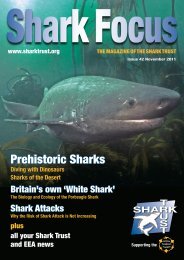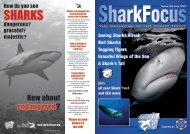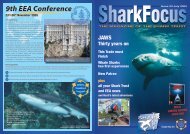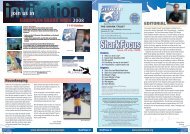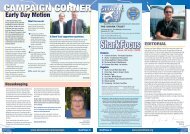Shagreen Ray Leucoraja fullonica - The Shark Trust
Shagreen Ray Leucoraja fullonica - The Shark Trust
Shagreen Ray Leucoraja fullonica - The Shark Trust
Create successful ePaper yourself
Turn your PDF publications into a flip-book with our unique Google optimized e-Paper software.
COMMERCIAL IMPORTANCE<br />
<strong>The</strong>re is no targeted fishery for the <strong>Shagreen</strong> <strong>Ray</strong> but it is caught<br />
and landed in multi-species trawls throughout its range and by<br />
longlines in the north (Gibson et al., 2006; Serena, 2005).<br />
THREATS, CONSERVATION, LEGISLATION<br />
As with most species of European skate and ray, the current trends<br />
and status of the population are difficult to determine. <strong>The</strong>re is<br />
definite potential for overfishing and CEFAS surveys have not<br />
recorded the species in the North Sea since 1998. It is still recorded<br />
by Scottish surveys though in small numbers and deeper than<br />
expected, such as along the edge of the continental shelf at around<br />
200m (655ft) (Gibson et al., 2006).<br />
All rajids are managed under a Total Allowable Catch (TAC)<br />
system in EU waters. Between 1999 and 2005 the 6,060t TAC was<br />
reduced by 47% and by a further ~50% from 2005 to 2008 (ICES,<br />
2008). Originally the TAC applied only to areas IIa and IV, however in<br />
January 2009 the TAC was extended to include ICES divisions IIa, IIIa,<br />
IV, VIa-b, VIIa-k, VII and IX. <strong>The</strong> table below gives a summary of the<br />
TAC’s for the years 2004 to 2009.<br />
ICES<br />
Division<br />
2004 2005 2006 2007 2009 2009<br />
IIa, IV 3,503 3,220 2,737 2,190 1,643 1,643<br />
IIIa N/A N/A N/A N/A N/A 68<br />
VIa-b,<br />
VIIa-c,<br />
VIIe-k<br />
Supported by:<br />
N/A N/A N/A N/A N/A 15,748<br />
VIId N/A N/A N/A N/A N/A 1,044<br />
VIII, IX N/A N/A N/A N/A N/A 6,423<br />
(All figures in tons. European Union, 2009)<br />
Since 2008 European countries have been required to record<br />
most skate and ray landings by species to give a clearer picture<br />
of the status of populations in EU waters (ICES, 2008). Some Sea<br />
Fisheries Committees (SFC) around the UK have byelaws which<br />
stipulate a minimum disc width (DW) for landed skates and rays,<br />
measured from the extreme tips of the pectoral fins. <strong>The</strong> SFC’s which<br />
implement these and the details are shown in the table below.<br />
SFC DW (cm) Other<br />
Cumbria 45 Cannot land wings less than 22cm in<br />
their maximum dimension<br />
Kent & Essex 40 Cannot land wings less than 19cm in<br />
their maximum dimension<br />
Southern 40 Cannot land wings less than 20cm in<br />
their maximum dimension<br />
South Wales 45 Cannot land wings less than 22cm in<br />
their maximum dimension<br />
States of 36<br />
Guernsey<br />
(Cumbria SFC, Unknown; Kent & Essex SFC, Unknown; South Wales<br />
SFC, Unknown; Southern SFC, 2006; NFFO, 2004)<br />
However, such localised management strategies are unlikely to<br />
be significant for the conservation of regional populations (Fowler<br />
et al., 2005). Many recreational anglers return any sharks, skates and<br />
rays they catch alive and some angling clubs have begun tag and<br />
release programmes (Holt, 2005). As with most European skate and<br />
ray species, there is very little effective management in place to<br />
protect the <strong>Shagreen</strong> <strong>Ray</strong>.<br />
Text & Illustrations © <strong>Shark</strong> <strong>Trust</strong> 2009<br />
IUCN RED LIST ASSESSMENT<br />
Near Threatened (2008).<br />
Data Deficient in Mediterranean.<br />
HANDLING AND THORN ARRANGEMENT<br />
• Handle with care.<br />
• Row of strong thorns on midline.<br />
• Row of thorns on head.<br />
• Orbital thorns.<br />
<strong>Shagreen</strong> <strong>Ray</strong>



